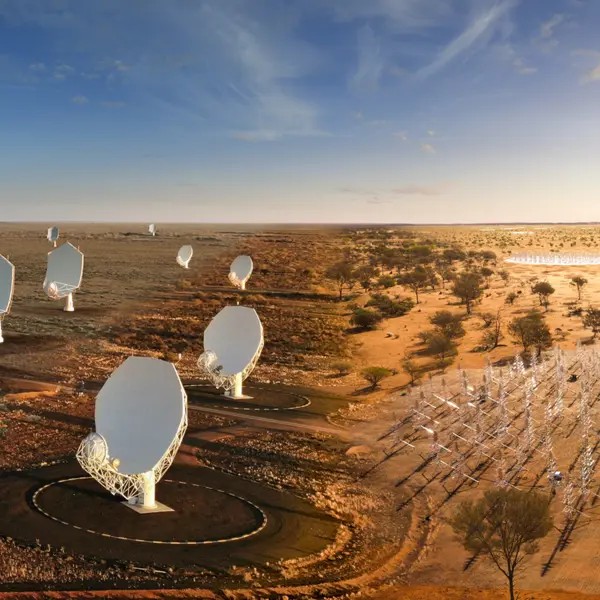
The sharpest images of the universe are created when radio telescopes around the world work together. For the first time, the world's largest network of radio telescopes, EVN, has observed together with South Africa's MeerKAT, the southern hemisphere's most powerful radio telescope. The images, of a distant black hole jet, open up new possibilities for cosmic discoveries and international cooperation.
South Africa's large radio telescope MeerKAT consists of 64 satellite dishes, each 13.5 meters in diameter, distributed over an area of up to 8 km in the Karoo region. MeerKAT, built and operated by the South African Radio Astronomy Observatory SARAO, is a national facility within South Africa's National Research Foundation (NRF) and was inaugurated in 2018.
EVN is the world's most sensitive network of radio telescopes working with technology for very long-baseline interferometry, VLBI. With synchronized observations over distances of up to 9,000 kilometers, many individual antennas act as a single telescope, the size of the Earth. The technology enables imaging of the universe's radio waves with unparalleled sharpness.
Now MeerKAT has taken its place in the EVN network for the first time, thanks to a collaboration between astronomers at SARAO in South Africa and at the European Joint Institute for VLBI ERIC (JIVE), based in the Netherlands.
The researchers aimed MeerKAT together with many other telescopes, including the 25-meter telescope at the Onsala Space Observatory in Sweden, at a galaxy far out in the universe. The galaxy J0123+3044 shines thanks to a stream of energetic plasma ejected from a supermassive black hole.
The resulting images not only represent a technological achievement but also demonstrate how MeerKAT’s extraordinary sensitivity significantly enhances both the resolution and sensitivity of observations over very long distances.
– MeerKAT with its 64 antennas is as sensitive as a single dish antenna with a diameter of one hundred meters. This improves the image quality significantly. This is a big step forward for future observations with the telescopes of the SKA Observatory, says Jun Yang, astronomer at Onsala Space Observatory, Chalmers.
Astronomers are now working around the world to build the two telescopes that make up the SKA observatory: SKA-Low in Australia and SKA-Mid in South Africa.
Sweden is about to become a member of the SKA Observatory, a global collaboration that builds and operates advanced radio telescopes in Australia and South Africa. Both MeerKAT and EVN are precursor telescopes for the SKA project.
Among the scientific goals of the SKA Observatory is to connect the SKA-Mid telescope with others around the world, just as has now been done with MeerKAT.
The new observations were made with MeerKAT in South Africa together with individual radio telescopes in China, Germany, Italy, Latvia, the Netherlands, Poland, South Korea, Spain, Sweden (the 25-meter telescope in Onsala), South Africa’s Hartebeesthoek Radio Observatory, and as well as the e-Merlin network in the United Kingdom.
Read more
Press release at SARAO: https://www.sarao.ac.za/news/pr_evn-meerkat/
Press release at JIV-ERIC: https://www.jive.eu/news/earth-sized-radio-observatory-just-got-better-south-africas-meerkat-telescope-joins-forces

Photographer: EVN map image ©Paul Boven, JIVE (satellite image: Blue Marble Next Generation, courtesy of NASA Visible Earth)
